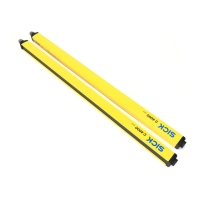Operating Instructions Chapter 4
C4000 Select
8012247/RI61/2007-11-30 © SICK AG • Industrial Safety Systems • Germany • All rights reserved 23
Configuration
When the extended I/O safety inputs are not at their expected state (e.g. both inputs
should be Active (High) or Inactive (Low)), they are considered “discrepant”. The inputs
m
ust reach an equivalent value before the internal discrepancy timer expires. Failure to
reach an equivalent value before the discrepancy time expires will cause a lock-out
condition to occur.
Electrical-mechanical devices (e.g. emergency stop buttons or safety interlock switches)
must not be connected to the extended I/O.
You must ensure that the Extended I/O DIP switch setting satisfies your safety
application requirements!
When cascading one or more devices with the C4000 Select, you must ensure that the ex-
tended I/O DIP switch setting(s) for extended I/O is enabled as required for your applica-
tion. You must also validate that the C4000 Select and all cascaded protective devices
perform in accordance with your risk assessment, risk reduction strategy as well as appli-
cable local, regional and national regulatory requirements.
You must ensure that protective device inputs attached to the inputs of the extended
I/O connection can be read safely!
The inputs (IN1, IN2) of an extended I/O connnection enable the 24 V DC PNP-semicon-
ductor safety outputs from a self-monitoring sensor (e.g. another C4000 Select or an
S300/S3000 safety laser scanner) to be read safely. The sensor connected to the inputs
of the extended I/O connection (e.g. guest C4000 Select or S3000 safety laser scanner)
must …
be self-monitoring and detect any error conditions that may occur with its output signal
switching devices (OSSDs) using test signals. The host C4000 Select filters these test
signals out.
execute a safe shutdown of the switching outputs when any error is detected.
Integrated safety mechanisms ensure detection of possible errors on safety capable inputs
for:
Internal errors on safety capable inputs which prevent the inputs from returning to the
safe state. An internal error on a safety capable input is a failure of the C4000 Select
electrical input circuitry.
Discrepancy of the dual-channel input evaluation
Additional measures must be made to address any external errors that cannot be moni-
tored internally by the C4000 Select. In addition, you must exclude any external errors that
could occur due to selected user configuration parameters.
4.2 Beam coding
If several safety light curtains operate in close proximity to each other, the sender beams
of one system may optically interfere or even align itself with the receiver of another sys-
tem. With code 1 or 2 activated, the receiver can distinguish the beams designated for it
from other beams. The following settings are available: non-coded, code 1 and code 2.
Use different beam codings if the systems are mounted in close proximity!
Systems mounted in close proximity to each other must be operated with different beam
codings (code 1 or code 2). If this precaution is neglected, the system may be impaired in
its protective function by the beams from the neighboring system and so change to the
unsafe state. This would mean that the operator is at risk.
WARNING
WARNING

